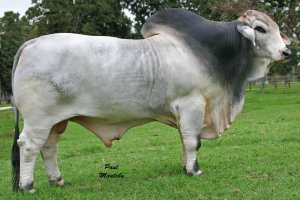

Brahman: When farmers set out to invest in livestock they need to take into consideration a few crucial factors to get the most out of the venture.
Choice of animal and breed comes first.
This is what in the long run results in the success or otherwise of the product. Few meat rivals come close to the Brahman beef cattle. The breed is head and shoulders above the rest.
The Brahman is a relatively rare breed in Kenya and was first developed in America from the Bos indicus breeds (Zebu) of India principally the Gir, Nellore and Gujarat.
It is widely bred in countries like Australia, South Africa, Namibia and Brazil.
Through controlled crossbreeding and genetic selection of desired traits, a high-yielding breed was achieved.
Like most other Zebu breeds (for example, the East African Shorthorn Zebu and the Boran) commonly available in Kenya, the Brahman possesses traits that make it ideal for the tropical climate.
FOR BEEF PRODUCTION
The cattle have “borrowed” traits from the breeds from which it was developed. Such traits include good tolerance to extreme heat, resistance to most diseases, pests and parasites in Africa and a good feed-to-beef conversion ratio.
The Brahman is easily identifiable by its large drooping ears, prominent hump and calm demeanour. Its dewlap is characteristically large with folds of loose skin.
The loose skin helps the animal in regulating body temperature through the increased body surface area.
The colour of the coat varies. The commonest is various shades of grey to almost black. Further, the fur of the animal is usually short and very smooth. This makes it hard for the animal to host pests and parasites on its skin.
Some Brahman cattle have a red coat. The mature bulls are usually darker than the cows. The horns of these cattle usually tend to curl upwards but in some cows they appear to protrude backwards.
The Brahman was developed with beef production being the main motive and it does not disappoint.
A mature bull packs incredible amounts of meat on the bone and can weigh between 500kg to 1,100kg.
It can achieve this at the age of three to three-and-a-half years.
VERY PRODUCTIVE
This is well way above its closest rival, the Boran, which weighs between 500kg to 850kg at the same age.
Though not best known for high milk output, Brahman cows produce an average of 8.5kg of milk a day in the first four months of lactation.
This is quite good compared to other Zebu breeds. Furthermore, the cows remain productive even at 15-18 years of age. This sets them apart from most breeds which tend to “retire” early.
Bos indicus breeds were exposed to harsh conditions in their original home, India. This helped them develop traits to adapt to a harsh environment such as lack of adequate pasture.
These cattle thrive best in open grazing as opposed to zero grazing. They are resistant to bloating because they feed lightly. Enough feed should, however, be made available.
The Brahman is very popular when farmers want to cross-breed in order to improve stock.
GOOD FOR CROSS-BREEDING
The cows have good calving considering the large size of their calves (calves are born weighing 30-33kg).
This is made possible by the sloping rump of the females. The females also have a very good mothering and protection instinct for their young.
The Brahman calves also grow faster than most Zebu. On average the calves gain 0.65g a day before weaning, with the male calves growing faster than the females.
The Brahman can easily be cross-bred with most common breeds in East Africa.
The Brahman should definitely be a candidate for anyone who wants to invest in beef animals.
Ultimately, the success of the enterprise depends on the care given to the animals so they can give good returns.
 Contact Jaguza Support
Contact Jaguza Support